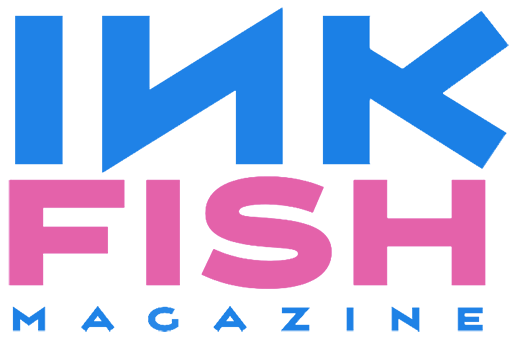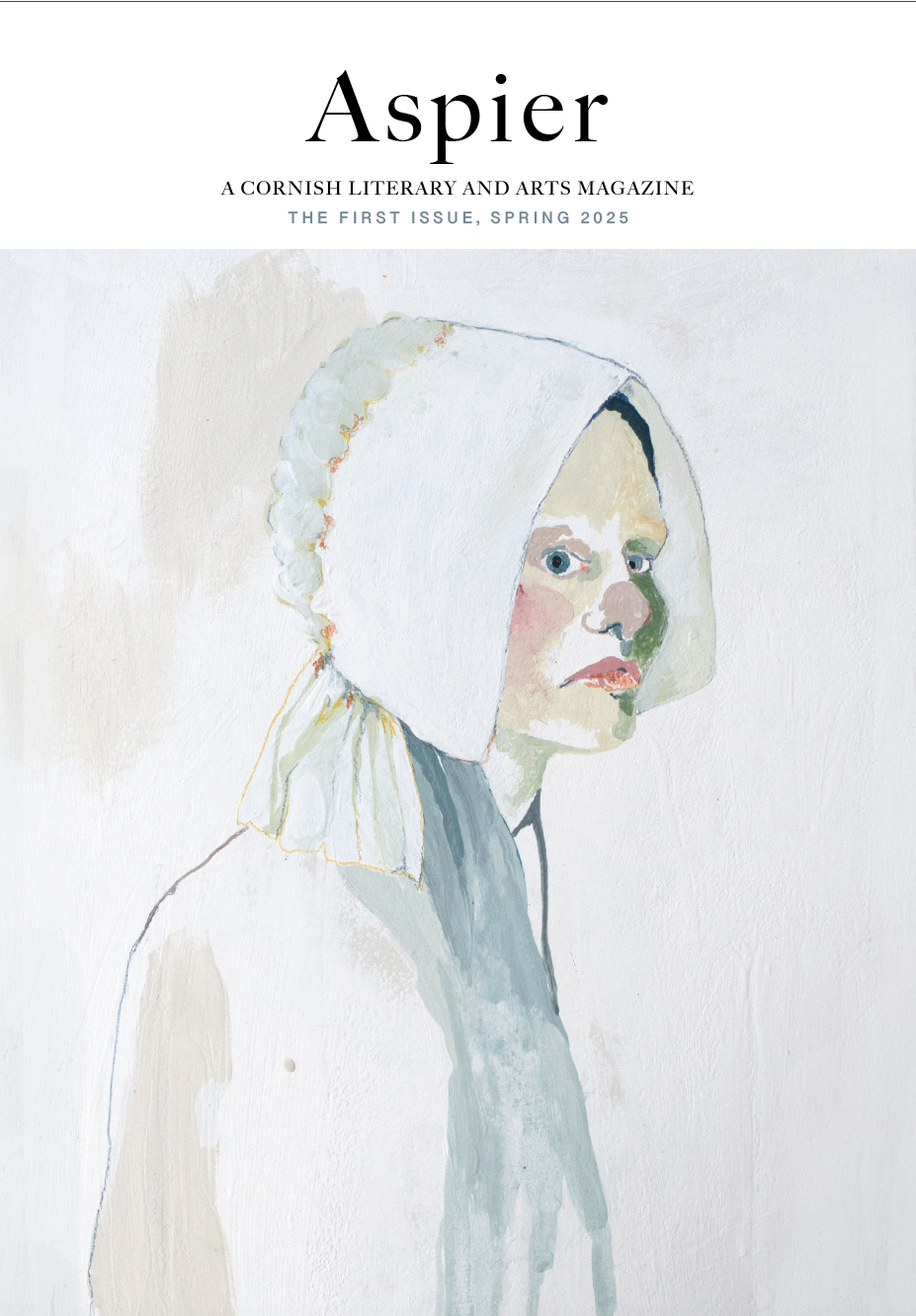Interview with Sravya Raju
Editor of Aspier Magazine
Questions by Kate Horsley
The debut edition of your beautiful magazine, Aspier, has just launched! Can you tell us the story of how that came to be, who you’ve included in it, and the work that went into making it so gorgeous?
It’s really exciting to be able to say it’s finally out, it’s been a long time in the making!
I got interested in periodicals and magazines, late-19th century ones, when I was an undergraduate student thinking about what to do for a dissertation. And although I ended up veering away from that topic as a dissertation choice, that was when I came across Denys Val Baker’s The Cornish Review. I came back home to Cornwall and through working at Krowji and doing tiny bits of writing here and there, I became aware both of how saturated the region was with writers, artists, and creative practitioners, and also that there still didn’t seem to be a serialised, contemporary print publication to chronicle these amazing people and their output.

I was thinking a vehicle that was agile and non-partisan to join the dots, covering present-day Cornish culture essentially, with potential space for arts commentary and journalism. I waited a couple of years with that idea on the back burner, and then decided if no one was doing it, then maybe I could give it a go. There wouldn’t be someone interviewing me for the role of editor or telling me I couldn’t do it because I lacked the experience; I could self-appoint and have full creative control and responsibility. Which was very appealing.
I applied and got a small grant from Real Ideas Organisation for the project in November 2022. It took about six months after that to get the title cleared before I could do a wider call-out to writers to contribute and pieces started to come in. I wanted Aspier to be a friendly home to both emerging and established writers and artists, a little like Inkfish has set out to do. These could be contributors who identify as Cornish, who have adopted Cornwall as their home, writers and artists whose work engages with the region, or Cornish practitioners who have since moved away and are part of our diaspora now. And I didn’t want the subject material to necessarily relate to Cornishness. Contributors are free to submit anything on any subject they wanted to.
I sifted through Cornish and Cornwall-based visual artists I had in mind for the cover illustration, and contacted a couple of different people before I got in touch with Elizabeth Loveday whose work I really loved. Elizabeth creates these wonderful, often slightly dark, wild, whimsical depictions of characters with a spin on stock Cornish imagery. But each of them is so suggestive and full of storytelling. I knew that, instead of landscapes, I wanted characters on the cover who could reference a piece inside on the cover, and Elizabeth’s work is both distinctive and character-driven. She was immediately enthusiastic about the pilot, and kindly did me a few different iterations based on some of the contributor pieces I’d sent to her. There was conversation around configuration and colour (I love this process of exploration and back and forth collaboration!). I can’t remember how it was finally decided that a bal maiden and miner would be a good call, probably it emerged as one potential idea when we met for a coffee and had Elizabeth’s paintings on the table in front of us, but I thought they would speak to a few of the Issue 01 contributor pieces that heavily reference our mining heritage from Chris Silver, Sovay Berriman, and then the conversation Roel Meuleman and I had with Bosena’s Denzil Monk about Enys Men.
It wasn’t a particular planned route I took or any sort of experience or honed skills behind me that made Aspier happen, just the willingness to put in a lot of voluntary hours into a project over the last couple of years and then a pretty clear sense of what I wanted to make – and stubbornness to plough through setbacks to get it out.
Can you tell us a bit about your work as an editor? Do you enjoy it?
Absolutely love it. The editor role at least, seeing these works come in, getting my hands on someone’s piece, taking a metaphorical pen to it and screening for pace, lucidity, where things don’t quite fit together. I do find it difficult having to feed back suggestions when you know that a work means so much to its creator and they may have worked on it for an extensive period of time. Most of the pieces are untouched, there are a few that were edited a little. With Issue 01 behind me, I would probably be more emboldened next time around to make deeper editorial changes and suggestions with work that comes in. I really love the design part of it too, that was all brand new to me so a slow process of trying things out as I don’t speak computer, but satisfying by the end.
But it’s also a real privilege to get to work with and build relationships with the contributors, and hope that I’m being nurturing and encouraging in interactions. From my very limited experience, it’s a really nerve-wracking and exposing thing to proffer a piece of writing, and you’d hope for someone a bit compassionate and thoughtful on the other end to receive it. So, I’m going to try to emulate that as best I can. Though I have found it incredibly tricky to do it on my own though, a bit like being 100% responsible for a screaming baby for two years and wishing there was someone else or a few others to hand it to for a change, and for them to look after it in their own way with renewed energy and knack for singing lullabies. I’m hoping to get an editorial team behind me for the next issue to help share the project out – I think that would be a much more fertile process ideas-wise, less exhausting, and it’s much better to collaborate and share the excitement about a project you are working towards with a group of like-minded creative producers.
Where do you work and what’s your creative space like?
I’m laying claim to a small study space. It has various furniture piled into it like a couple of bookcases and a leftover chest of drawers, and also my desk at the window. I’ve stuck a lot of prints and some drawings up on the wall behind me, by accident they seem to be various versions of beiges, creams, and blacks. On my desk is a random assembly of icons besides a pot of pencils and a pot of pens. There’s a couple of Toulouse-Lautrec postcards, a blue Emily Tapp vase with dried stems in it, and a diminutive, grinning Mexican skeleton in graduation robes and a mortar board which my sister bought me prematurely in a shop in Merida before I knew I’d passed my degree finals.
Because through apparently magical powers it had manifested a good result, I find it to be a morbid token of good luck. A dead plant is next to it which is less inspirational. A little terracotta squirrel I made at school whose ears have since fallen off. A ceramic ghost made by Kate Aimers. There’s often a scented candle on the go to give the room a bit more of a harmonious vibe than it actually has (I’ve run out of tealights again, need to grab another pack). I also have this grey-blue egg made from marble from the Ellora caves at Ajanta. None of these things has a practical purpose (apart from the pot of pens), but they are all lined up on the back of my desk anyway. Currently I also have a little plastic pot of blue Indian ink and a paintbrush on the desk which I’m painting thank you notes for when I’m wrapping the Aspier envelopes up. In full-blown aesthete mode, I’ve been signing them with this beautiful striped, hand-turned wooden Pencole pen I bought at a Cornish fair last year, so that sits in its little velvet pouch in the drawer, I just need to develop the penmanship to operate it properly. And there’s a lot of less lovely general clutter I need to throw away.
I’ve got limited floor space, and a little production line going for wrapping which I do cross-legged on the rug, hemmed in by a box of envelopes and boxes of Aspier issues. And there’s always music playing. At the moment for wrapping books in the evening it’s stuff that’s more dulcet to zone out to – this week it’s been tracks like R.O.B.Y.N. by Luke de-Sciscio, Coolshit Bullshit by Danika, Save My Soul by Sabine McCalla, maybe some This is The Kit, Alex G, some Fionn Regan like Collar of Fur, Snowy Atlas Mountains, or just the whole of his gorgeous 2024 album which has been replaying quite a bit this year since seeing him live at The Cornish Bank a few months ago where he was brilliant.
Do you have a preference for one particular art form or writing form?
I love short stories, the shorter the better, like one-pagers. I recently read Lou Beach’s 420 characters, and absolutely loved it. It made me feel better about the surreal, fragmentary nonsense that I often generate. In terms of what I like to write, this would be the easiest thing to produce. There’s a pile of stray short shorts, some funny when I read them back even if I can’t remember when I wrote them. Some of them are actually funny, most of them are weird. They’ve built up since I was having a difficult time at university and which I don’t want to throw away but I don’t know what to do with. But I find them a pleasure to shape and return to and rewrite.
The focus of Inkfish Edition 4 is on nature and the environment. Are those themes that find their way into your work?
I’m really fascinated by our human relationship with the space we inhabit, whether that’s urban or rural, and of reframing ourselves more like animals that are part of an ecosystem rather than regarding the natural landscape as being our playground onto which we project ideas in a very anthrocentric manner. Writing about Cornwall I drift more towards thinking about the right to roam, the absurdity of ownership of a piece of land, acquisition and plunder vs. stewardship and active protection and preservation of natural spaces, and regeneration and growth that comes from that. And I’m also really interested in thinking about the placement of brown and black bodies in these spaces which doesn’t usually spring to mind when picturing idyllic British or Cornish pastoral scenes, or when picturing who is operating custodianship and protection of green spaces, again shifting those preconceived notions and unconscious bias. I’ve touched upon this in my writing before, but they are definitely thoughts I’d like to develop further.
What are you working on at the minute?
Getting Issue 01 out and beginning to think about how to secure Issue 02! There have been a few ideas in terms of creative writing rattling around for years now that I haven’t got around to sitting down and working up. If I can take a few weeks off to have a break, travel across the border, hopefully I can work on those. I won’t share those ideas now in case I back out of them and look like an idiot. We’ll see what happens!
About Sravya Raju
Sravya Raju is originally from and based in Cornwall. She bimbled across the Tamar for a BA (Hons) in English Literature, French, and History of Art at Durham University, then a MA in English: Issues in Modern Culture at UCL. She returned home to work in the creative sector and has written bits and bobs along the way – scripts, copywriting, poems, and research papers among them. Her research interests veer towards late Victorian and modernist literature, and in terms of reading for pleasure, the love discovered at university for mid-twentieth century American prose and poetry hasn’t shaken off.


